In the growing landscape of electric vehicles, two cars stand out for their blend of luxury, performance, and innovation: the Audi Q4 e-tron and Volvo EX40. With both vehicles embodying the modern electric SUV ethos, this comparison will elucidate key technical aspects, innovations, and overall driving experiences offered by each model.
Audi Q4 e-tron vs Volvo EX40 – Performance, range & efficiency compared
Two cars, one duel: Audi Q4 e-tron meets Volvo EX40.
Which one wins in performance, efficiency and value for money? Find out now!
Design and Dimensions
The Audi Q4 e-tron boasts a more robust presence with a length of 4588 mm, a width of 1865 mm, and a height of 1632 mm. In contrast, the Volvo EX40 is slightly smaller at 4440 mm in length, 1863 mm wide, and 1647 mm high. While the Q4 e-tron appears more imposing, the EX40's design reflects a contemporary Scandinavian aesthetic that appeals to minimalist enthusiasts.
Powertrains and Performance
Both vehicles offer a range of powertrains. The Audi Q4 e-tron presents options from a base power of 170 HP to a peak output of 340 HP, featuring rear-wheel and all-wheel drive configurations. The Volvo EX40, on the other hand, starts with 238 HP and reaches up to 408 HP. The EX40's performance is impressive, especially with a 0-100 km/h time of 4.8 seconds in its most powerful variant, compared to the Q4 e-tron’s quickest time of 5.4 seconds.
Efficiency and Range
Efficiency remains a strong point for both SUVs. The Audi Q4 e-tron offers consumption rates between 15.9 kWh/100km to 17.4 kWh/100km, with an electric range that can reach up to 554 km. Conversely, the Volvo EX40 demonstrates slightly better efficiency with consumption between 16.6 kWh/100km and 17.5 kWh/100km, and a maximum range of 576 km. Both models qualify for CO2 efficiency class A, emphasizing their environmentally friendly credentials.
Battery Capacity and Charging
Battery capacity plays a crucial role in an EV’s performance. The Audi Q4 e-tron is available with battery options of 52 kWh and 77 kWh, while the Volvo EX40 offers a slightly higher capacity with 67 kWh and 79 kWh. Charging times are competitive, though specifics depend on the charging infrastructure used. Both cars support rapid charging, ensuring efficiency in longer journeys.
Interior and Technology
Interior quality and technology integration are paramount in the luxury SUV segment. The Audi Q4 e-tron features a sophisticated cabin with high-quality materials, a futuristic touchscreen interface, and ambient lighting that elevates the driving experience. Conversely, the Volvo EX40 showcases its Swedish design ethos with a focus on simplicity, sustainability, and intuitive tech. Both cars come equipped with advanced safety features and driver assistance systems, making them suitable for modern urban commuting.
Practicality and Comfort
When it comes to practicality, the Q4 e-tron offers a trunk capacity of 520L, surpassing the EX40's 410L. However, both vehicles cater adequately to families and consumers needing space. With a seating capacity of 5, both SUVs provide ample room for passengers, with a heightened emphasis on comfort in the Q4 e-tron through its plush seating options.
Conclusion: Which One to Choose?
Ultimately, the choice between the Audi Q4 e-tron and Volvo EX40 may reflect personal preferences. The Q4 e-tron appeals with its greater range, trunk capacity, and a slightly more potent performance lineup. In contrast, the Volvo EX40 shines with faster acceleration and a stylish design that resonates with eco-conscious buyers. Whichever model you choose, you are assured a terrific driving experience that aligns with the future's electric aspirations.
Here’s where it gets real: The technical differences in detail
Costs and Efficiency:
Looking at overall running costs, both models reveal some interesting differences in everyday economy.
Audi Q4 e-tron has a minimal advantage in terms of price – it starts at 39600 £, while the Volvo EX40 costs 42800 £. That’s a price difference of around 3291 £.
In terms of energy consumption, the advantage goes to the Audi Q4 e-tron: with 15.90 kWh per 100 km, it’s barely noticeable more efficient than the Volvo EX40 with 16.60 kWh. That’s a difference of about 0.70 kWh.
As for range, the Volvo EX40 performs barely noticeable better – achieving up to 576 km, about 22 km more than the Audi Q4 e-tron.
Engine and Performance:
Power, torque and acceleration say a lot about how a car feels on the road. This is where you see which model delivers more driving dynamics.
When it comes to engine power, the Volvo EX40 has a clearly perceptible edge – offering 442 HP compared to 340 HP. That’s roughly 102 HP more horsepower.
In acceleration from 0 to 100 km/h, the Volvo EX40 is slightly quicker – completing the sprint in 4.60 s, while the Audi Q4 e-tron takes 5.40 s. That’s about 0.80 s faster.
There’s no difference in top speed – both reach 180 km/h.
There’s also a difference in torque: Audi Q4 e-tron pulls barely noticeable stronger with 679 Nm compared to 670 Nm. That’s about 9 Nm difference.
Space and Everyday Use:
Beyond pure performance, interior space and usability matter most in daily life. This is where you see which car is more practical and versatile.
Both vehicles offer seating for 5 people.
In curb weight, Audi Q4 e-tron is minimal lighter – 2035 kg compared to 2040 kg. The difference is around 5 kg.
In terms of boot space, the Audi Q4 e-tron offers noticeable more room – 535 L compared to 410 L. That’s a difference of about 125 L.
In maximum load capacity, the Audi Q4 e-tron performs slight better – up to 1490 L, which is about 90 L more than the Volvo EX40.
When it comes to payload, Audi Q4 e-tron hardly perceptible takes the win – 515 kg compared to 480 kg. That’s a difference of about 35 kg.
Who wins the race?
The Volvo EX40 proves to be edges out slightly and therefore becomes our DriveDuel Champion!
Volvo EX40 is the better all-rounder in this comparison.
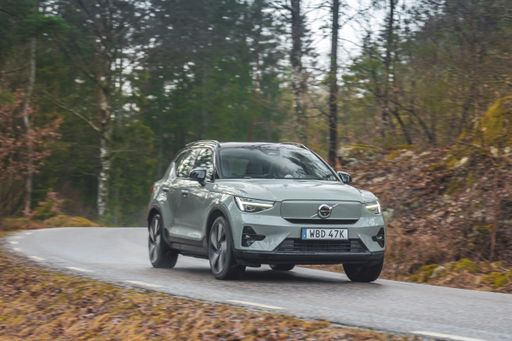 @ Volvo Cars
@ Volvo Cars
Volvo EX40
Audi Q4 e-tron
The Audi Q4 e-tron brings Audi polish into the electric crossover scene, pairing a sleek exterior with a refined, airy interior that makes everyday driving feel distinctly premium. It’s an easy-to-live-with EV that balances comfort and real-world usability with intuitive tech, making it a smart choice for buyers who want electric mobility without giving up Audi character — and yes, it still looks good in the driveway.
details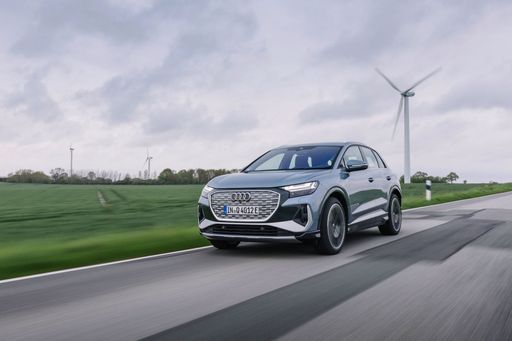 @ Audi AG
@ Audi AG
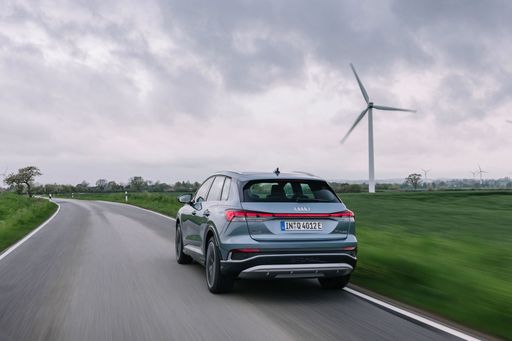 @ Audi AG
@ Audi AG
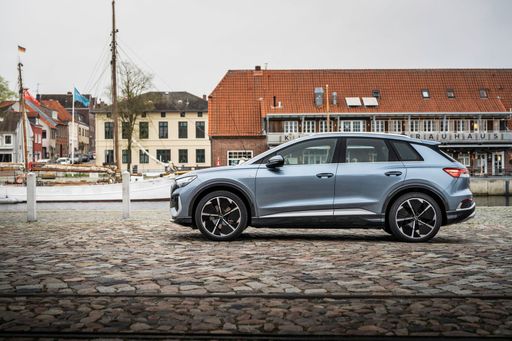 @ Audi AG
@ Audi AG
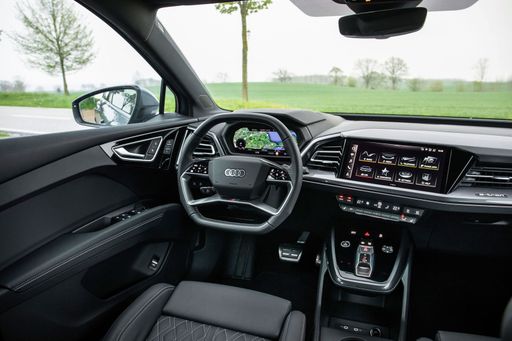 @ Audi AG
@ Audi AG
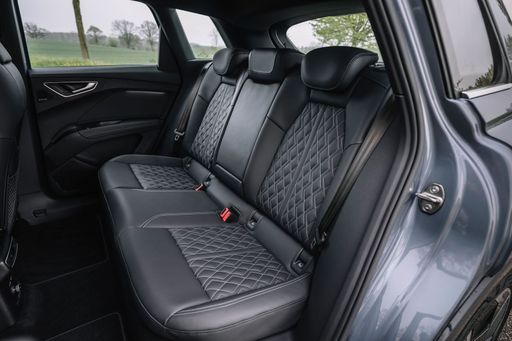 @ Audi AG
@ Audi AG
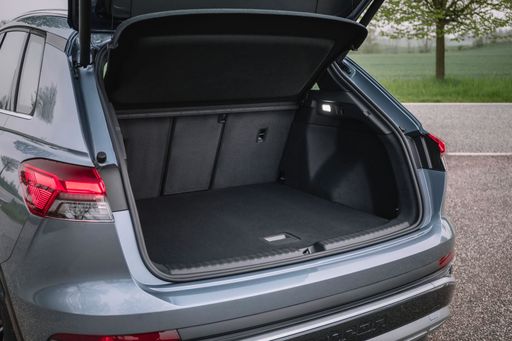 @ Audi AG
@ Audi AG
Volvo EX40
The Volvo EX40 represents a new chapter in the brand's commitment to sustainability and innovation, combining elegant Scandinavian design with cutting-edge electric vehicle technology. With its spacious interior and intuitive technology, the EX40 provides a comfortable and connected driving experience. The focus on eco-friendly materials and efficient performance makes it an attractive choice for those seeking a responsible and stylish drive.
details @ Volvo Cars
@ Volvo Cars
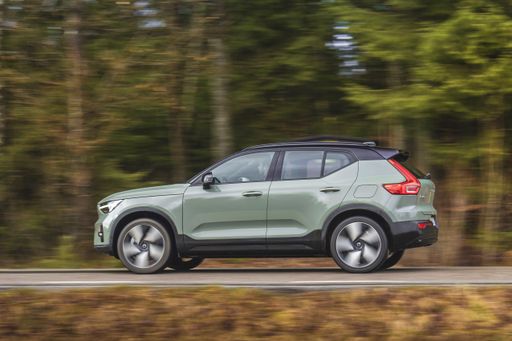 @ Volvo Cars
@ Volvo Cars
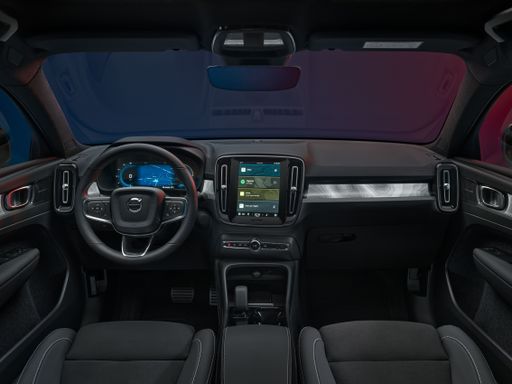 @ Volvo Cars
@ Volvo Cars
 @ Audi AG
@ Audi AG
|
 @ Volvo Cars
@ Volvo Cars
|
|
|
|
Costs and Consumption |
|
|---|---|
|
Price
39600 - 58800 £
|
Price
42800 - 58200 £
|
|
Consumption L/100km
-
|
Consumption L/100km
-
|
|
Consumption kWh/100km
15.9 - 17.4 kWh
|
Consumption kWh/100km
16.6 - 17.6 kWh
|
|
Electric Range
406 - 554 km
|
Electric Range
480 - 576 km
|
|
Battery Capacity
59 - 77 kWh
|
Battery Capacity
67 - 79 kWh
|
|
co2
0 g/km
|
co2
0 g/km
|
|
Fuel tank capacity
-
|
Fuel tank capacity
-
|
Dimensions and Body |
|
|---|---|
|
Body Type
SUV
|
Body Type
SUV
|
|
Seats
5
|
Seats
5
|
|
Doors
5
|
Doors
5
|
|
Curb weight
2035 - 2235 kg
|
Curb weight
2040 - 2170 kg
|
|
Trunk capacity
520 - 535 L
|
Trunk capacity
410 L
|
|
Length
4588 mm
|
Length
4440 mm
|
|
Width
1865 mm
|
Width
1863 mm
|
|
Height
1614 - 1632 mm
|
Height
1647 mm
|
|
Max trunk capacity
1460 - 1490 L
|
Max trunk capacity
1286 - 1400 L
|
|
Payload
505 - 515 kg
|
Payload
430 - 480 kg
|
Engine and Performance |
|
|---|---|
|
Engine Type
Electric
|
Engine Type
Electric
|
|
Transmission
Automatic
|
Transmission
Automatic
|
|
Transmission Detail
Reduction Gearbox
|
Transmission Detail
Reduction Gearbox
|
|
Drive Type
Rear-Wheel Drive, All-Wheel Drive
|
Drive Type
Rear-Wheel Drive, All-Wheel Drive
|
|
Power HP
204 - 340 HP
|
Power HP
238 - 442 HP
|
|
Acceleration 0-100km/h
5.4 - 8.1 s
|
Acceleration 0-100km/h
4.6 - 7.3 s
|
|
Max Speed
160 - 180 km/h
|
Max Speed
180 km/h
|
|
Torque
310 - 679 Nm
|
Torque
420 - 670 Nm
|
|
Number of Cylinders
-
|
Number of Cylinders
-
|
|
Power kW
150 - 250 kW
|
Power kW
175 - 325 kW
|
|
Engine capacity
-
|
Engine capacity
-
|
General |
|
|---|---|
|
Model Year
2023 - 2025
|
Model Year
2024
|
|
CO2 Efficiency Class
A
|
CO2 Efficiency Class
A
|
|
Brand
Audi
|
Brand
Volvo
|
What drive types are available for the Audi Q4 e-tron?
The Audi Q4 e-tron is offered with Rear-Wheel Drive or All-Wheel Drive.
The prices and data displayed are estimates based on German list prices and may vary by country. This information is not legally binding.
